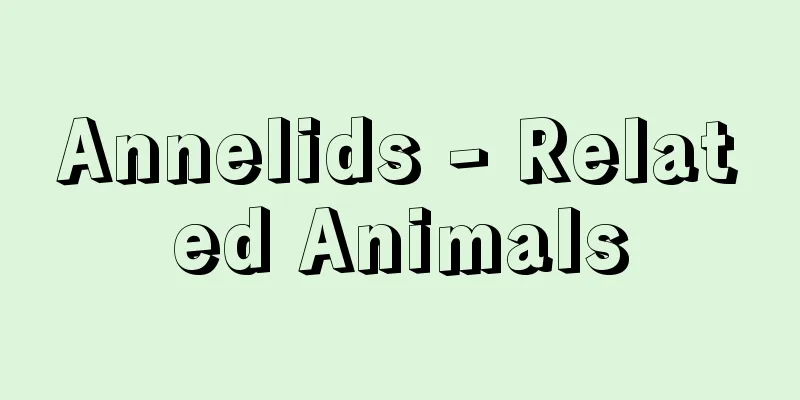Annelids - Related Animals

|
A group of animals that includes lugworms and earthworms and constitutes the phylum Annelida in animal taxonomy. Generally, they are elongated, cylindrical animals, and the name of the phylum comes from the Latin annulus (meaning ring). They are mainly found in the sea, but are also widely distributed in freshwater and on land, with about 7,700 species known worldwide. [Minoru Imajima] formThe body is bilaterally symmetrical and divided into roughly equal-sized segments, with each segment divided by a thin membrane, forming a single chamber with a body cavity. However, some species have no internal partitions and form a single large chamber, but this is due to a degeneration during development. Among annelids, the polychaetes are the most well-differentiated in external appearance, with tentacles, eyes, and antennae developed on the head, and warty legs with unique shapes on the sides of the body depending on the species. However, oligochaetes and leeches lack tentacles or warty legs, and in oligochaetes, setae grow directly from the body wall, while leeches lose setae and instead have suckers on both ends of the body. The surface of the body is covered with a thin chitinous membrane, and glandular cells are well developed. The body wall is made up of a double layer of muscle, with circular muscles surrounding the outside and longitudinal muscles running vertically on the inside. The digestive tract runs straight through the center of the body from the mouth to the anus, and is attached to various organs. Leeches in particular have several pairs of blind pouches that temporarily store the blood they have sucked. Polychaetes have chitinous jaws and teeth in the pharynx, which function to pinch food and send it into the esophagus, and leeches with jaws can injure the skin of their prey. Following the pharynx, oligochaetes have a cisterna and gizzard, where food is often ground up. The vascular system is closed, with the dorsal vessels running on the dorsal side of the digestive tract and the ventral vessels running on the ventral side, and sending side branches between the two vessels to the body wall and internal organs for each body segment. Blood passes from the dorsal vessels through the body wall and the footpads, then to the ventral vessels to the rear of the body, and from the ventral vessels through the intestinal wall to the dorsal vessels, then to the front of the body. In oligochaetes, the three pairs of annular vessels at the front of the body are thickened, and pulsate to pump blood. Blood is red because it contains dissolved hemoglobin, but some species have green or colorless blood. Most polychaetes generally breathe through the skin, but many polychaetes, including gill worms and sea lions, have gills of unique shapes. The nervous system consists of a pair of ventral nerve cords (ventral medulla) that extend from a pair of cranial ganglia in the head and run along the ventral midline, with each body segment having its own ganglion, forming the so-called ladder-like nervous system. Waste products that accumulate in the body cavity are discharged from the body through long, slender tubular nephridia. In principle, each segment has a pair of nephridia, one on each side, but in practice, their number has decreased and they are often only found in certain segments. The mouth of the nephridia is located in the previous segment, where it collects waste products, which it passes through the diaphragm and discharges from the ventral surface of the next segment. Sensory organs are particularly well developed in polychaetes, but oligochaetes have various sensory cells scattered over the epidermis and do not form special sensory organs. [Minoru Imajima] Reproductive methodsThey are either dioecious or hermaphroditic; generally, protoannelids, polychaetes, and unicorns are dioecious, while oligochaetes and leeches are hermaphroditic. In oligochaetes and leeches, several segments at the front of the body fuse and thicken to form an annulus during the reproductive period. The eggs are isoyolk or endyolk and usually undergo spiral cleavage. Protoannelids, polychaetes, and unicorns develop from fertilized eggs into trochophora larvae (trochophore larvae) that float in the sea for a time, then metamorphose into a benthic life and become adults. On the other hand, oligochaetes and leeches undergo direct development, becoming adults directly from fertilized eggs without metamorphosis. They also reproduce asexually by growing many buds from parts of the body that eventually leave the parent. [Minoru Imajima] ClassificationAnnelids are classified into six taxonomic classes: (1) Primitive annelids: There are many small species and they have a primitive body structure. Most species live in the sand on the coast, but some live in lakes and groundwater. There are about 90 known species in the world. (2) Polychaetes: The most diverse of all annelids, most of which are marine. They can grow to lengths of 5 millimeters to 1.5 meters, and most live in mud or sand, but some attach themselves to other objects or live a floating life. There are approximately 4,000 known species in the world. (3) Oligochaeta: These are the so-called earthworms. Large ones live on land, while small ones live in fresh water. Some live as parasites on other animals. Most species have no tentacles or warty legs, and only a few setae. There are about 3,100 known species in the world. (4) Leeches Regardless of size or type, their body consists of 34 segments and has suckers at the front and back. They are widely distributed on land, in fresh water, and in the sea. There are about 300 known species in the world. (5) Echinodermata: They have a proboscis at the front of their bodies that they do not retract into the body, and they feed by dragging it along the sea floor. They have no segments either inside or outside their bodies, but a segmented structure can be seen during development. All are marine. About 70 species are known worldwide. (6) Suckerworts: They have a disk-shaped body with a smooth surface, and five pairs of warty legs arranged vertically on the ventral side, with four pairs of sucker-like lateral organs between them. They live symbiotically or parasitically on the surface or inside the bodies of echinoderms such as sea lilies. There are about 130 known species in the world. [Minoru Imajima] Source: Shogakukan Encyclopedia Nipponica About Encyclopedia Nipponica Information | Legend |
|
動物分類学上の1門Annelidaを構成するゴカイやミミズを含む動物群。一般に細長い円筒状の動物群で、門の名はラテン語のannulus(環という意味)に由来する。海産が主であるが、淡水や陸上にも広く分布していて世界で約7700種が知られている。 [今島 実] 形態体は左右相称で、ほぼ同じ大きさの体節に分かれ、体内も節ごとに薄い膜の隔膜で仕切られていて、体腔(たいこう)をもった一つの室になっている。しかし、なかには体内に隔膜がなく、一つの広い室になっているものもあるが、これは発生の過程で退化したものである。環形動物のうち、外形がもっともよく分化したのは多毛類であって、頭部に触手、目、感触器などが発達し、体側には種類によってそれぞれ特有な形のいぼ足がある。しかし、貧毛類やヒル類では触手やいぼ足もなく、貧毛類では体壁から直接剛毛が生じ、ヒル類では剛毛もなくなり、かわりに体の両端に吸盤をもっている。 体表はキチン質の薄い膜で覆われ、腺(せん)細胞がよく発達している。体壁は二重の筋肉層になっていて、外側には環状筋が取り巻き、内側に縦走筋が縦に走っている。体内の中央には口から肛門(こうもん)に続く消化管が直走しているが、これにはいろいろな器官が付属し、とくにヒル類では吸った血を一時蓄える盲嚢(もうのう)が数対ついている。多毛類では咽頭(いんとう)にキチン質のあごや歯があって、食物を挟んで食道内に送り込む働きをし、ヒルのうちあごをもつものは相手の皮膚に傷をつける。咽頭に続いて貧毛類では嗉嚢(そのう)や砂嚢があり、ここでよく食物を擦り砕いている。 血管系は閉鎖血管系で、消化管の背側に背行血管、腹側に腹行血管が走って、両血管の間を体節ごとに体壁や内臓に側枝を送っている。血液は背行血管から体壁やいぼ足を通り、腹行血管に移って体の後方へいき、腹行血管から腸壁を通って背行血管へ移り、体前方へ向かって流れる。貧毛類では体前方の3対の環状管が太くなっていて、拍動して血液を送り出している。血液はヘモグロビンを溶解しているために赤いが、種類によっては緑色や無色の血液もある。呼吸は一般に皮膚呼吸のものが多いが、エラミミズやウミエラビルなどのほか多くの多毛類ではそれぞれ独特な形のえらをもっている。 神経系は頭部にある1対の脳神経節から1対の腹側神経索(腹髄)が伸びて腹側正中線を走り、各体節ごとに神経節があって、いわゆる梯子状神経系(はしごじょうしんけいけい)を形づくっている。 体腔内にたまった老廃物は細長い管状の腎管(じんかん)によって体外に排出している。腎管は原則として各節に左右1対あるが、実際にはその数が減って特定の体節にしかない場合が多い。腎管の口は前の体節内にあって老廃物を集め、隔膜を突き抜けて次の体節の腹面から体外に排出している。感覚器官は多毛類でとくに発達しているが、貧毛類では種々の感覚細胞が表皮中に散布していて、特別な感覚器をつくらない。 [今島 実] 生殖法雌雄異体または雌雄同体で、一般に原始環虫類、多毛類、ユムシ類は雌雄異体で、貧毛類とヒル類は雌雄同体である。貧毛類とヒル類では生殖時期になると体前方の数節が融合して太くなり、環帯をつくる。卵は等黄卵か端黄卵で通常螺旋(らせん)分割を行う。原始環虫類、多毛類、ユムシ類は受精卵からトロコフォラ幼生(担輪子(たんりんし)幼生)となって一時海中を浮遊したのち、変態して底生生活に移り成体になる。一方、貧毛類とヒル類では受精卵から変態せずに直接成体になる直接発生を行う。また、体の一部から多くの芽を出して成長し、やがて親から離れてゆくという無性生殖も行う。 [今島 実] 分類環形動物は分類学上、次の六つの綱に分けられる。 (1)原始環虫類 小形の種類が多く、原始的な体制をしている。大部分の種が海岸の砂の中にすむが、湖や地下水にすむものもある。世界に約90種が知られている。 (2)多毛類 環形動物のうちもっとも種類が多く、ほとんどが海産。体長5ミリメートルから1.5メートルになるものがあり、大部分は泥や砂の中にすむが、他物に付着したり、一生の間浮遊生活するものもある。世界に約4000種が知られている。 (3)貧毛類 いわゆるミミズ類で、大形のものは陸上に、小形のものは淡水にすみ、ほかの動物に寄生するものもある。ほとんどの種類は触手やいぼ足がなく、少数の剛毛をもつのみである。世界に約3100種が知られている。 (4)ヒル類 体は大小や種類に関係なく、環節が34節と決まっていて、前部と後部に吸盤がある。陸上、淡水、海に広く分布している。世界に約300種が知られている。 (5)ユムシ類 体の前方には体内に引き込まない吻(ふん)があり、これを海底の上をはわして餌(えさ)をとる。体の外部にも内部にも体節がないが、発生の途中では体節構造がみられる。すべて海産。世界に約70種が知られている。 (6)吸口虫類 体は円盤状で、表面は平滑、腹側には5対のいぼ足が縦に並んで、その間に4対の吸盤状の側器官がある。棘皮(きょくひ)動物のウミユリ類の体表や体内に共生または寄生生活する。世界に約130種が知られている。 [今島 実] 出典 小学館 日本大百科全書(ニッポニカ)日本大百科全書(ニッポニカ)について 情報 | 凡例 |
>>: Winter training - Kangeiko
Recommend
Mycobacteria - Kinjinrui
…The primary hyphae become secondary hyphae throu...
Urabe clan
This clan originated from an ancient clan that se...
NOE - Nooie
...The number of bonded protons can be determined...
Madara Island - Madara Island
An island in the Iki Strait (Genkai Sea) at the n...
constipation
Concept Constipation is characterized by infrequen...
Geranium erianthum (English spelling) Geranium erianthum
…[Mitsuko Shimizu]. … *Some of the terminology th...
Gold Chain
〘 noun 〙① A chain made of gold. Also, a chain made...
Measures for protection - Kango no sochi
...A national facility that temporarily houses de...
Fire Responsibility - Shikkeshikinin
If a fire causes damage to others, liability for t...
Pedro
Date of birth: December 9, 1392 Son of King John I...
Sand play therapy - Sand play
It is a type of psychotherapy founded by M. Lowenf...
Hypocyrta radicans (English spelling) Hypocyrtaradicans
… [Kenzo Fujiwara]. … *Some of the terminology th...
Wheatstraw, P. - Wheatstraw
...Since the 1960s, as the social lives and consc...
Notophthalmus viridescens
…Only two of the eggs of the Alpine salamander de...
Mesh size - and
…Amido means a fishing spot or a fishing area, an...






![Suifu [village] - Suifu](/upload/images/67cbf17f3ca21.webp)


